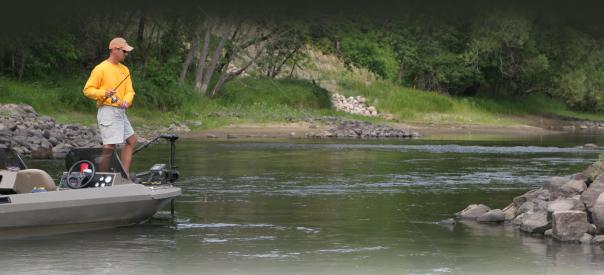
In flowing water, summertime river smallmouth pull out all the stops. A 2-pound, current-pumped smallie makes you think you’ve tagged a 4-pounder. And their aerial acrobatics leave me shaking my head, even after catching them for 30-some years.
The focus here is on small to midsized rivers and free-flowing portions of larger rivers that feature hard bottom, good gradient, and lots of skinny water that can only be fished by wading, paddling, or jet-boating. During a typical summer, flow is moderately low and rivers run clear. Much of the smallmouth population relates to faster-moving water at this time, and fish use all sorts of current breaks to rest or ambush prey.
Early on, I pursued smallmouth by casting classic river baits like the Original Floating Rapala, Mepps Spinner, and Heddon’s Tiny Torpedo. Over the years, however, my approach has changed dramatically. While old favorites still catch fish, I now rely on an array of newer lures for specific situations.
Buzz Up a Reaction Strike
Buzzbaits are the ultimate river reaction bait for smallmouth. That’s a lesson I learned from Kevin Turner, owner of River Pro Boats, a fine line of jet boats. Until meeting Turner a few years ago, I rarely used a buzzer on the river.
Turner fishes a buzzbait all summer on the upper Mississippi River, where he fishes frequently. He instructs anglers to make long casts, “peel” the lure back at 90 degrees to the river’s flow, and use 40-pound braided line to ensure positive hook-ups in strong currents. Bouncing his bait off a craggy shore, he drags it into the water, churning it past protruding rocks in fast water, and burns it across swirling current seams. This high-speed, unorthodox approach attracts crushing strikes in just inches of water.
A buzzbait is now my first choice for rushing water when there’s only time for one quick cast to a current break before the boat is swept past. Smallmouths, however, have even less time to decide whether or not to strike the passing bait. Hungry or not, they react!
Casting distance with a buzzbait can be increased substantially by removing the silicone skirt and replacing it with an aerodynamic soft plastic body, such as a YUM Houdini Shad or Berkley PowerBait Jerk Shad. Or leave the hook bare, as Turner sometimes does.
Go Natural with Drifters
If reaction baits hold down one end of the lure presentation spectrum, drift baits occupy the other. The key is to offer bass an artificial that’s natural in both appearance and delivery. Cast a lightly weighted or unweighted subtle softbait upstream of an intended target area so current carries it to fish in a natural drift, like the presentation of a nymph to a trout.
Many river anglers rely on a tube bait with a light insert head. Although a tube is my choice in spring and fall, I’ve had far better success with a stickworm during summer. Choose your favorite blunt-ended worm and rig it for drifting. YUM Dingers are especially popular on my home water, the Allegheny River, followed by Case Magic Stiks, and Senkos.
For shallow water, I rig a Dinger on an unweighted Mustad Impact or Mega-Lite hook. When more weight is needed for deeper or faster water, I use a 1/16-ounce weighted hook. With the weight centered on the shank, the natural, horizontal position of the bait is maintained. Others add a light bullet sinker or crimp a Water Gremlin Bull Shot several inches in front of the bait.
I don’t like to crimp lead, due to the risk of weakening thin line. To add weight in front of a lure, I use a 1/16-ounce Top Brass sinker (harder than lead so it isn’t mashed by rock), set 6 inches ahead of the Dinger with a rubber Peg-It.
For a 4-inch stickworm, a 2/0 or 3/0 fits nicely. Dale Black, a river rat buddy (no relation), prefers Mustad’s 5/0 Mega-Lite. He argues that the gap on the light-wire Mega-Lite is similar to that of a 3/0 Mega-Bite offset. The big hook surely works, as his stickworm prowess has earned him the nickname “Captain Dinger.”
A drop-shot rig also makes an effective drift presentation. Adjust sinker weight so it barely drags on the bottom, with the lure dancing 4 to 6 inches above. This setup is particularly effective in rivers, because it allows you to hold or “check” the rig to fish a key spot more thoroughly. As it drifts, steer the rig into an eddy behind a large rock, deadfall, or bridge piling where the weight settles to the bottom, the bait fluttering until a bass can no longer refuse it. Or let the rig settle into the deep, shadowy section of a run, a washout hole, the slope of a rockbar, the tailout of a pool—anywhere you expect a group of smallmouth to hold.
Where craws are prime prey, hook a 4-inch green pumpkin crayfish imitator like a YUM Craw Papi or Net Bait Paca Craw. Other options include a Case Hellgrammite, Berkley Gulp! Minnow, or any other streamlined softbait that won’t twist your line in current.






![Air gun 101: The differences between .177 & .22 – Which jobs they do best ? [Infographic]](https://airgunmaniac.com/wp-content/uploads/2020/09/g44-218x150.jpg)








































